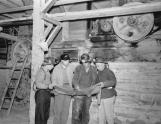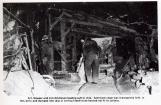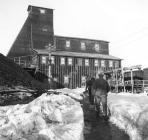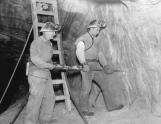15
ROOM AND BOARD - 70c PER DAYRoom and board were provided about 1923.
The cookhouse was the old Peter Murray residence. Mrs. Elizabeth (Langille) Purdy (Pye) was the first to run the business. She provided three a meals a day plus bed for 70c per man, and this price maintained for years.
Mrs. William Langille ran the cookhouse 1926-28.
Norman MacBauurie took over in 1928 and in 1929 Mrs. Wallace Carty contracted the business from Mr. MacBurrie, and so continued for about six years.
An additional bunk house, which eventually became the first school at the Mine (1937), was built in 1928 when the evaporator plant was being constructed. The building was moved after its stint as a school and used as a change (dry) house, until the Mine closed.
17
Art Napper and Jim Aitcheson loading salt into a box car.18
A group of miners with an official checking a map of the mine beside the lift1951
Malagash, Nova Scotia, Canada

19
Miners checking a plan at the top of the Malagash Salt Mine in 1951.21
An extract from an interview with Kenny Wilson. Kenny speaks about the working conditions at the Malagash Salt Mine.So what was that like you spent some of the time underground, that must have been quite hard being underground especially during the winter months for 8 hours?
Well most of the miners were very happy to go underground in the wintertime. It was 51 degrees down there all the time.
Yes I suppose.
And in the summertime, er? I spent a lot of time underground in Pugwash of course on maintenance. And I became the maintenance superintendent after a few years. On a real hot day when you come up the shaft, come up in the skip and you first step out on the collar of the mine, the heat hits you. It's something like coming out of a department store after you've been in there for a while. People working in department stores have a hard time; it's an awful quick change. It seems a lot hotter than it is but you know what it feels like. But if you're down there for 8 hours at 51 degrees and you come up into that you're quite happy. The main thing, even in the summertime it's nice and cool and in the wintertime it's nice and warm.
And you said conditions were good down there?
Oh yes. In Pugwash you had electric lights; you had some in Malagash too of course. And every miner has a lamp on his belt, a battery on his belt and a lamp on his hat anyway. And when you're working on machines and crawling underneath and stuff, you can take that off. And there's emergency lights that automatically come on the same as they do everywhere else underground.
23
HOURS OF WORKHubert Byers says that when he commenced working in the mine, autumn 1939, that ten-hour shifts were worked. Oakley Dickson says that when he was first employed in autumn of 1941, that eight hour shifts were worked six days a week. Actually union records show that an eight-hour day was instituted September 10th, 1940. Nine-hour shifts were worked for a short while prior to this date.
24
Three miners and official at the lift in the Malagash Salt Mine1940
Malagash, Nova Scotia, Canada





